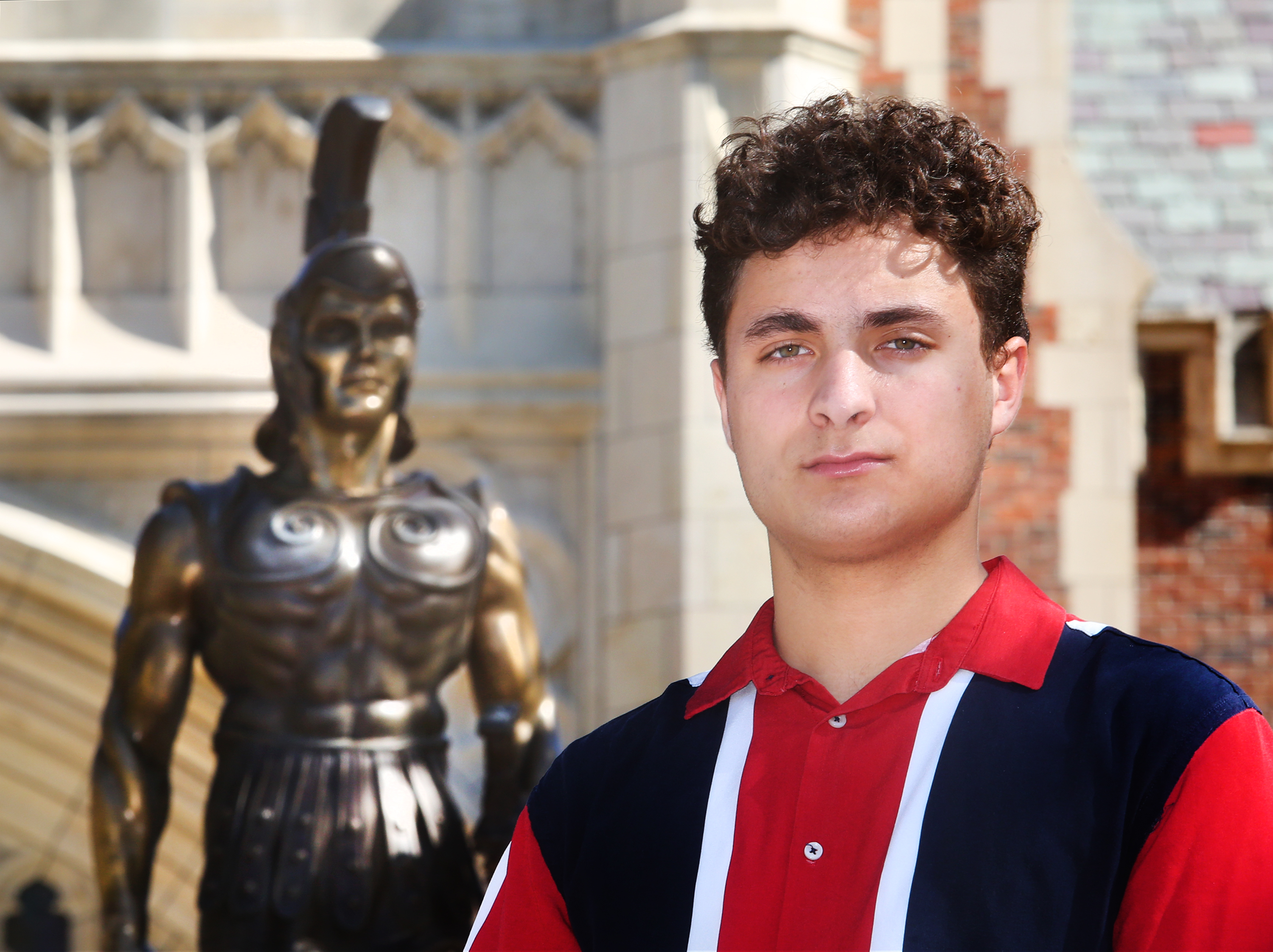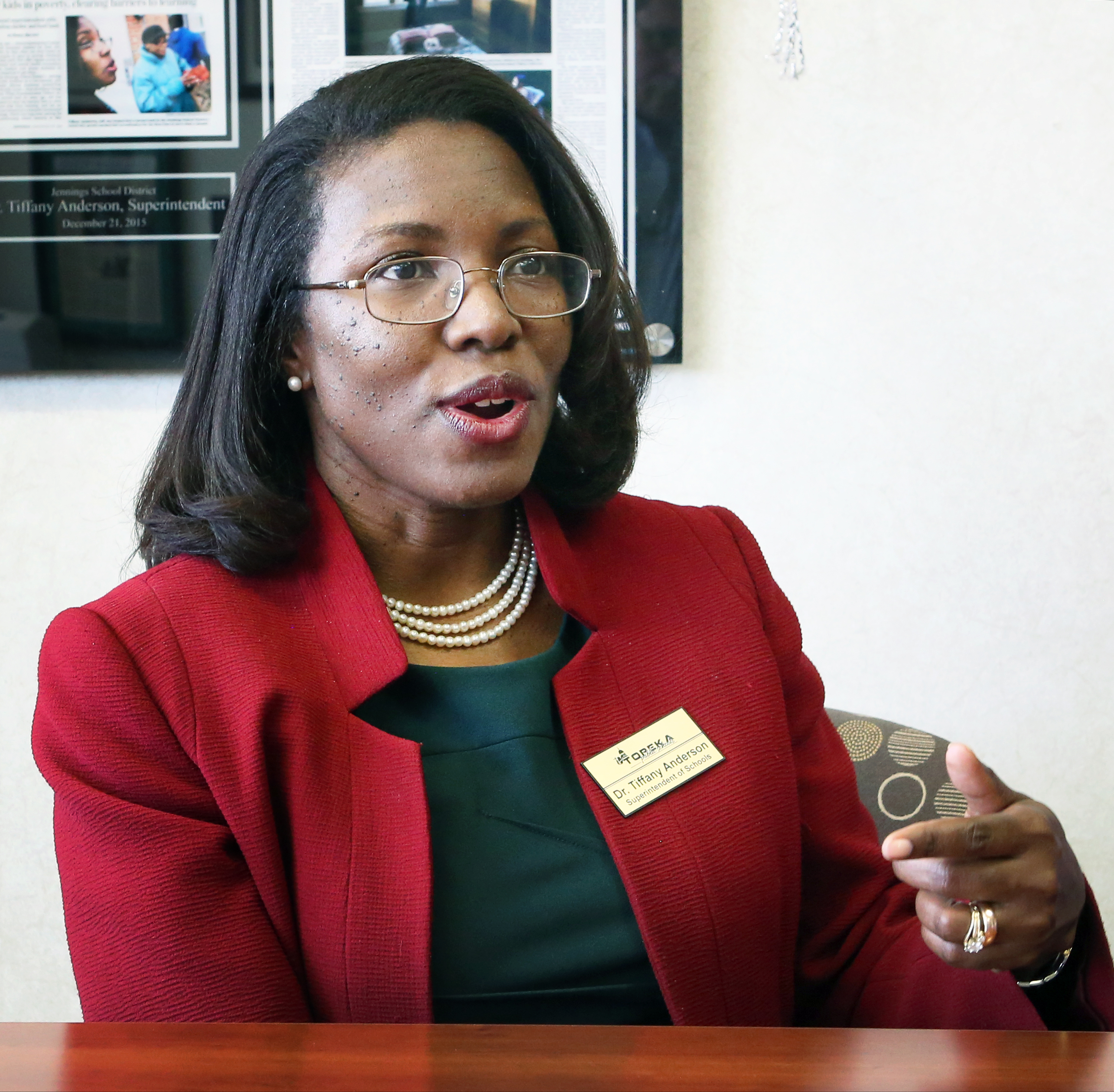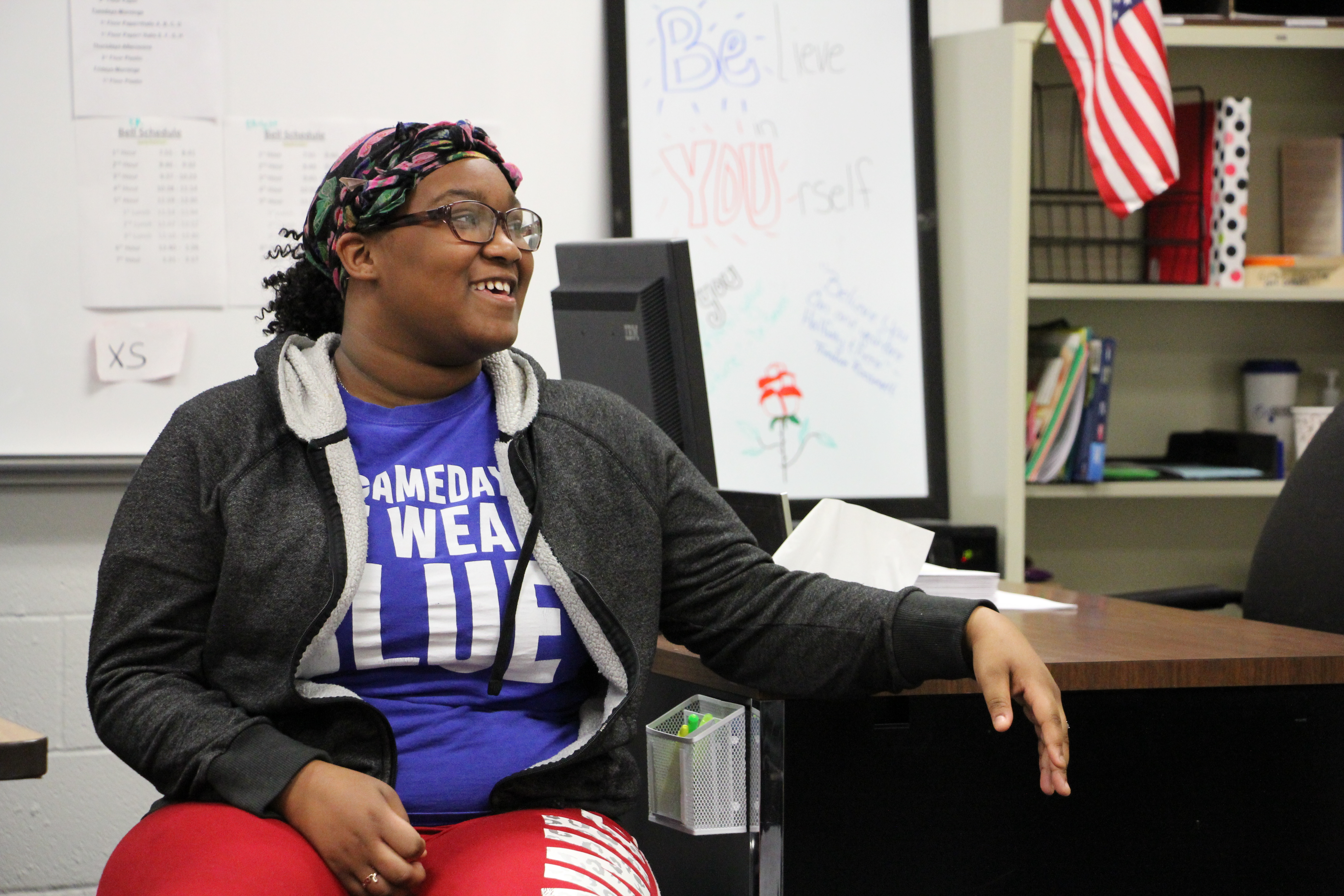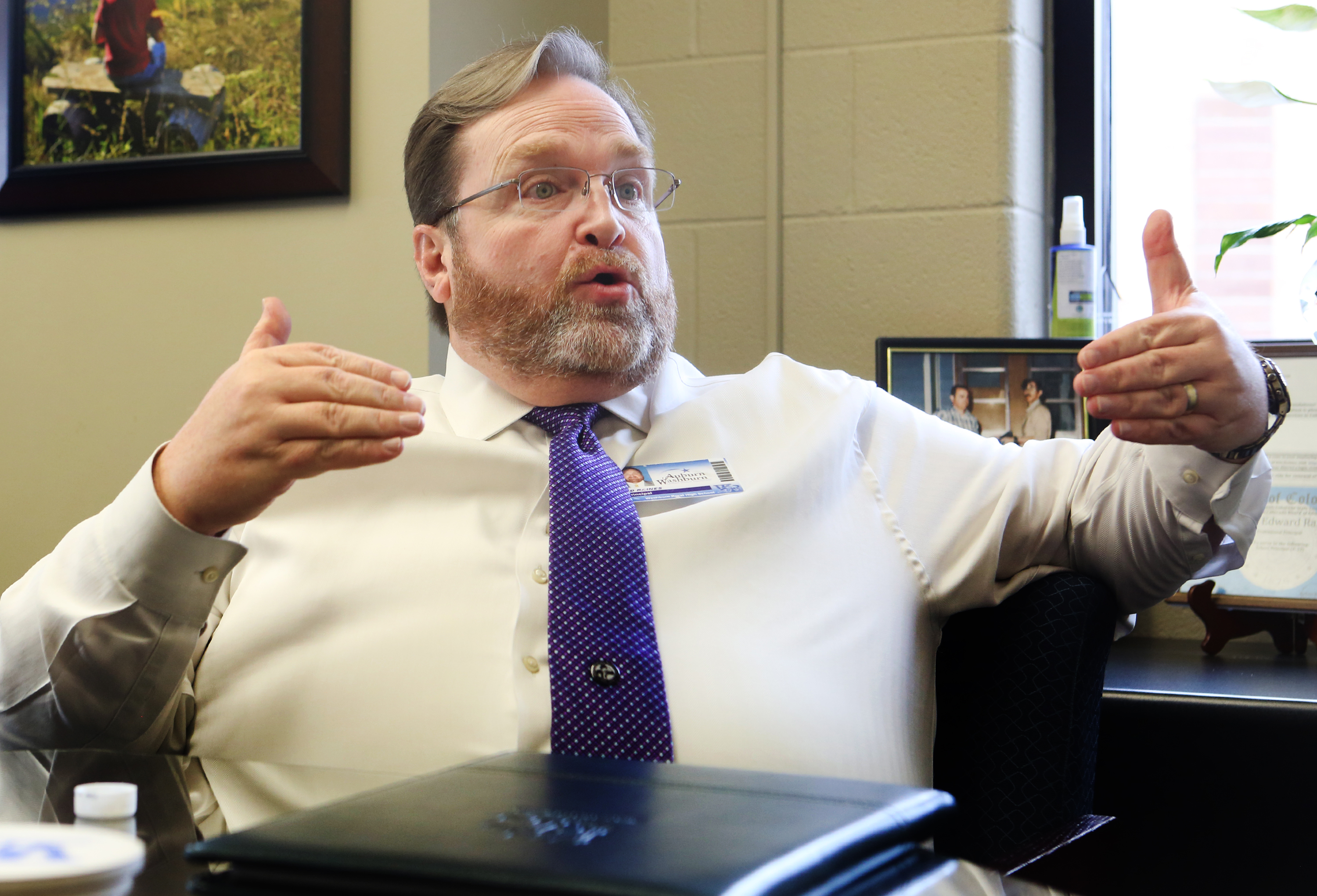Topeka schools still working to dismantle disparities
Washburn Rural High School students engage in a conversation during a Black Student Union meeting. [Katie Moore/The Capital-Journal]
Sixty-five years after Brown v. Board of Education opened the doors to equity, Topeka's public schools continue working to dismantle disparities in who takes advanced courses and who gets disciplined.
Jacob Gernon, a junior who identifies as white, said he noticed the student makeup in his advanced placement courses doesn't represent Topeka High's demographics.
"For example, my AP physics class, there's like 12 people in there, so not a whole lot," he said. "There's no people of color."
Other AP classes have some minorities, but they appear to still be underrepresented.
Gernon finds that problematic in a school that is majority-minority. White students can benefit from AP classes to push themselves further up in society, he said, but minorities need that too or even more.
The school also holds honors assemblies to recognize students with a 3.5 GPA or higher.
"It's pretty white-washed," Gernon said.
According to civil rights data collection from the U.S. Department of Education, in 2015, the most recent year data is available, white students accounted for 43 percent of Topeka High's enrollment and 70 percent of the gifted program.
"I think those statistics match up, at least what I see at my school," Gernon said.
Data provided from the district for 2017-18 indicates that 68 percent — or 75 of the 111 gifted students — were white. Fifteen students were Hispanic, 13 multiracial, four black, three Asian and one Native American.
Exposure to others promotes awareness and tolerance, Gernon said. That opportunity may be diminished when classes aren't reflective of the student population.
Gernon said he would like to see students be encouraged to take difficult courses from an early age and for teachers to encourage bright students.
"I feel like some teachers probably don't make a good enough effort for kids of color," he said.
At Jardine Middle School, Jayla Webb, said she feels like some of the teachers don't treat minorities equally.
"They single us out," the seventh-grader said.
If a black student wears a hoodie or a bandana, they have to take it off because teachers think it is gang-related, but they don't tell the white students that, she said. When a black student is sent to the office, they get an out-of-school suspension, but a white student is sent back to class, she said.
According to the civil rights data, black students made up 23 percent of the middle school's enrollment and 38 percent of the out-of-school suspensions. White students accounted for 42 percent of the students and 33 percent of out-of-school suspensions.

Finding equity
Topeka Public Schools superintendent Tiffany Anderson said she has worked to make the district more equitable since taking over in fall 2016. One example has been to remove financial barriers in taking the ACT and AP tests.
"The excuses that zip codes can determine your destiny is not an option in Topeka Public Schools or in any district," Anderson said. "It simply cannot, and if we allow for zip codes to determine where kids end up, then the whole goal behind integration has not had the impact that we would want it to have. We want every student to have the opportunity to succeed at the highest level."
Members of the district's equity council have focused on the school-to-prison pipeline this year, visiting the county's juvenile detention center.
Anderson said Unified School District 501's police department has examined what kind of consequences are being handed down and what impact that may have if a student becomes part of the criminal justice system. The district is also revisiting its approaches to behavior and trauma.
The equity council expanded this year by establishing youth equity councils at each school.
"We have to be prepared to address issues of privilege and understand those, be willing to have the courageous conversation that leads to action both on an adult level and a young adult level in the classrooms," Anderson said.
Diversity and inclusion are embedded in curriculum and hiring, she said. The district has expanded its recruiting efforts, traveling as far as Puerto Rico to hire teachers for its dual-language program.
Poverty is often at the root of differences in opportunity. Schools in the district have taken a holistic approach by integrating services like food pantries, clothing banks, laundry facilities and health care programs.
"In many cities, which includes Topeka, there's a high minority, high poverty population, so as we unpack that, we really are looking at what are the opportunity gaps that students of color or students who may not have English as a first language face," Anderson said.

Finding success
Despite systemic challenges, Anderson pointed to significant successes. In 2018, the racial achievement gap in graduation rates closed, according to district data.
At Washburn Rural High School, teacher Chris Exum started a black student union club in fall 2017 after conversations with principal Ed Raines. Exum had observed a lack of ACT participation and low scores.
"I would like to see just an overall fairness and openness to giving every kid equal opportunity and information," he said. "Don't just assume because a kid has a rough background, be it black or white, they shouldn't have a chance to be told about an honors course or about college."
The club was initially a safe haven where members could talk about social issues happening in the school building and nationally. Participants also have the opportunity to discuss tactful approaches for dealing with situations when it comes to racism, Exum said, particularly at a school that is primarily white.
"I think it's really just a way to raise awareness for us, people of color, like us being as a group, like somewhere we can talk and be comfortable, express our feelings," said freshman Kayceona Armstrong.
Raines said before the creation of the club, Black History Month wasn't celebrated in a significant way. Now during the month of February they have daily announcements, speakers and posters.
During a recent club meeting, Exum asked how many students were told to take an advanced placement class. Four students raised their hands in a room with about 25 students.
"Every year, we have this problem," Exum said.
According to the civil rights data, in 2015, zero black students were enrolled in the gifted program. Blacks were also underrepresented in calculus, chemistry and physics.
In the Auburn-Washburn school district, sixth-graders are given a math placement test.
"How they do on that test largely determines their math sequence from the end of their sixth grade year until they graduate from high school," Raines said. "Lots of times, minority kids perform lower on those assessments, and so they get tracked into lower classes. Consequently, they don't get to the upper level mathematics, which isn't to say we don't push kids to take the highest level course that they're capable of being successful in, but it's a complicated problem."
Raines said the school has engaged in one-on-one conversations with students to communicate the belief they can succeed in honors classes.
"It's just a lot of times they think they can be successful in there because no one has ever communicated that they can be successful in there," he said.
At the same time, there is outreach with parents during enrollment.

Closing the gap
Raines said ACT scores for minority students has increased. In 2015, the average score for black students was 18.8. It rose to 20 last year. The average score for Hispanic students rose 0.3 points and for students who identify as two or more races, the score increased from 22.9 to 24.2.
However minorities were overrepresented in in-school and out-of-school suspensions. Though blacks made up 4.9 percent of the student population in 2015, they accounted for 16 percent of the in-school suspensions and 21 percent of the out-of-school-suspensions.
"We respond to kids who are misbehaving, to kids who violate policy when it's brought to administration's attention pretty consistently," Raines said. "Now whether or not kids are being disproportionately referred — I'd like to think that's not happening, but I think it's misguided to infer anything from those numbers."
Raines said that number has since dropped to 13 percent for both categories.
During the club's discussion, the students considered the topic.
One student said he noticed the school resource officers congregate in the hallway where a lot of minority students gather.
Raines refuted that, saying the reason the officers concentrate in that location was because it was a main intersection.
"I think it's unfortunate that they feel that way," he said.
Exum said some teachers were likely raised in a suburban area like the one WRHS serves.
"They see this coming in, so they're just a little bit nervous and anxious and so out of the gate, they already have that guard built up," he said. "So what happens is, if a kid gets a little combative, like even a small amount, it's just boom, referral. So if I had to take the 'problem' out of my classroom, I can then feel comfortable in my environment to then teach kids who are like me."
Armstrong agreed that cultural differences may be misunderstood.
"Growing up in neighborhoods and around my family, there's no reason for me to act as people would say, 'white,'" Armstrong said.
Another student said when students flash a peace sign, teachers automatically assume it is a gang sign.
Raines said they have taken steps to train staff on recognizing microaggressions and integrated curriculum representing diverse backgrounds.
"It's just about being intentional day in and day out," he said.
Though WRHS has its problems just like any other school does, Exum said it remains a good school system for all.
"My job is to bring it out to the open and then say 'Hey, Washburn Rural, we have this problem.' To get better and greater, we have to solve each problem in a certain way," he said.
Echoing history
Some of today's challenges echo hurdles students in the Brown era faced. Several alumni of Topeka's segregated schools gathered to be part of a KTWU documentary.
Glenda Hicks-Lawton said when she started at a Topeka school when integration was enacted, the white teachers didn't know how to deal with the black students.
Other alumni of Topeka's segregated schools said when they were in high school, they weren't encouraged to pursue higher level courses or college. Carolyn Wims-Campbell said she was told she was pretty and smart and that she should be a waitress by a school counselor.
"I strongly detest the memory of her," she said.
Alonzo Harrison said the Brown decision "opened up a lot of doors," but was also a Pandora's box. He said he fears today's youths face difficult circumstances like the school-to-prison pipeline and police shootings. He wondered if the black community had assimilated so much that they lost a piece of their identity.
Several people expressed that we have come a long way, but more work remains.
"There's always more that we can do therefore, have we come far? Yes. Do we still have a long way to go? Yes," Anderson said. "And I think we as a community we have to be unapologetic about being willing to take the steps that are needed to level the playing the field and giving running starts particularly to the most vulnerable."
